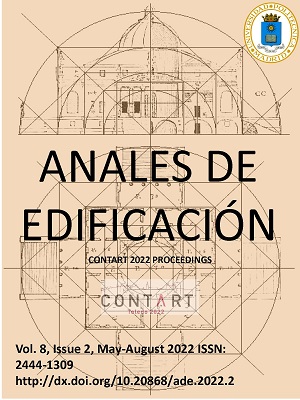Monitorización del consumo eléctrico a través de flujos de datos para la gestión inteligente y sostenible de edificios públicos = Monitoring electricity consumption through data streams for smart and sustainable management of public buildings
DOI:
https://doi.org/10.20868/ade.2022.5035Palabras clave:
Consumo eléctrico, Big Data, Digitalización, IoT, Monitorización, Electricity consumption, Digitisation, MonitoringResumen
La situación actual de escasez de recursos energéticos, unido a la ineficiencia en el uso de los edificios, y al avance de la tecnología sugiere la implantación de sistemas inteligentes para un uso más sostenible. En este texto se expone el desarrollo de un sistema de información heterogéneo que permite la monitorización de las infraestructuras edificatorias, y la integración de datos en una plataforma digital de visualización, dentro de una arquitectura escalable y de fuentes abiertas. Se ha implementado en el caso de estudio del municipio del Casar de Cáceres, y en el ámbito del consumo eléctrico de los edificios públicos; este municipio cuenta con unos 4500 habitantes y 39 contratos de contadores públicos que se agrupan según cada edificio y su tipología de uso (sanitario, educativo, culturales, asistenciales, otros, y alumbrado público). El uso de estos indicadores facilitará el establecimiento de políticas de evaluación de los edificios. Para finalizar, estos flujos de datos facilitarán la gestión municipal y mejorará la calidad de los servicios ofrecidos, permitiendo además mejorar su eficiencia y el ahorro de recursos, tanto naturales como humanos y económicos.
Abstract
The current situation of scarcity of energy resources, together with the inefficient use of buildings and the advance of technology, suggests the implementation of intelligent systems for a more sustainable use. This text presents the development of a heterogeneous information system that allows the monitoring of building infrastructures and the integration of data in a digital visualisation platform, within a scalable and open-source architecture. It has been implemented in the case study of the municipality of Casar de Cáceres, and in the field of electricity consumption of public buildings; this municipality has about 4500 inhabitants and 39 public meter contracts that are grouped according to each building and its type of use (health, education, cultural, welfare, other, and public lighting). The use of these indicators will facilitate the establishment of building evaluation policies. Finally, these data flows will facilitate municipal management and improve the quality of the services offered, as well as improving their efficiency and saving resources, both natural, human and economic.
Descargas
Referencias
M. A. Ahad, S. Paiva, G. Tripathi, and N. Feroz, “Enabling Technologies and Sustainable Smart Cities,” Sustain. Cities Soc., p. 102301, 2020, doi: 10.1016/j.scs.2020.102301.
V. Akuraju, P. Pradhan, D. Haase, J. P. Kropp, and D. Rybski, “Relating SDG11 indicators and urban scaling–An exploratory study,” Sustain. Cities Soc., vol. 52, p. 101853, 2020.
L. Burgas, J. Melendez, J. Colomer, J. Massana, and C. Pous, “Multivariate statistical monitoring of buildings. Case study: Energy monitoring of a social housing building,” Energy Build., vol. 103, pp. 338–351, Sep. 2015, doi: 10.1016/j.enbuild.2015.06.069.
C. Europea, “Eurostat,” 2020. [Online]. Available: https://ec.europa.eu/eurostat/web/energy
F. E. de M. y Provincias, “Hacia una Estrategia Local de Desarrollo Sostenible.” [Online]. Available: www.femp.eswww.municipiosyeconomiacircular.org.
Grafana Labs, “The leading open-source software for time series analytics,” 2020. [Online]. Available: http://grafana.org
O. Guerra-Santin and C. A. Tweed, “In-use monitoring of buildings: An overview of data collection methods,” Energy Build., vol. 93, pp. 189–207, Feb. 2015, doi: 10.1016/j.enbuild.2015.02.042.
InfluxData, “InfluxDB,” 2019. [Online]. Available: https://docs.influxdata.com/influxdb/v1.7/
Khan, A. Capozzoli, S. P. Corgnati, and T. Cerquitelli, “Fault Detection Analysis of Building Energy Consumption Using Data Mining Techniques,” Energy Procedia, vol. 42, 2013, doi: 10.1016/j.egypro.2013.11.057.
M. Kissinger and Z. Stossel, “An integrated, multi-scale approach for modelling urban metabolism changes as a means for assessing urban sustainability,” Sustain. Cities Soc., vol. 67, p. 102695, Apr. 2021, doi: 10.1016/J.SCS.2020.102695.
Ministerio de derechos sociales y Agenda 2030. Gobierno de España. Agenda 2030. [Online]. Available: https://www.mdsocialesa2030.gob.es/agenda2030/index.htm
Neo4j, “Neo4j,” 2021. [Online]. Available: https://neo4j.com/
“Pacto Global de Alcaldes por el Clima y la Energía (Global Covenant of Mayors for Climate & Energy – GCoM)” [Online]. Available: http://pactodealcaldes-la.eu/.
R. Palumbo, M. F. Manesh, M. M. Pellegrini, A. Caputo, and G. Flamini, “Organizing a sustainable smart urban ecosystem: Perspectives and insights from a bibliometric analysis and literature review,” J. Clean. Prod., vol. 297, p. 126622, May 2021, doi: 10.1016/J.JCLEPRO.2021.126622.
J. Y. Park et al., “A critical review of field implementations of occupant-centric building ,controls,” Build. Environ., vol. 165, p. 106351, Nov. 2019, doi: 10.1016/J.BUILDENV.2019.106351.
P. Puchol-Salort, J. O’Keeffe, M. van Reeuwijk, and A. Mijic, “An urban planning sustainability framework: Systems approach to blue green urban design,” Sustain. Cities Soc., vol. 66, p. 102677, Mar. 2021, doi: 10.1016/J.SCS.2020.102677.
Descargas
Publicado
Número
Sección
Licencia
1. Los autores conservan los derechos de autor y garantizan a la revista el derecho de una Licencia Creative Commons Atribución - Nocomercial 4.0 Internacional que permite a otros compartir el trabajo con un reconocimiento de la autoría y uso no comercial.
2. Los autores pueden establecer por separado acuerdos adicionales para la distribución no exclusiva de la versión de la obra publicada en la revista (por ejemplo, situarlo en un repositorio institucional o publicarlo en un libro).
Salvo indicación contraria, todos los contenidos de la edición electrónica se distribuyen bajo una licencia de uso y distribución “Creative Commons"












